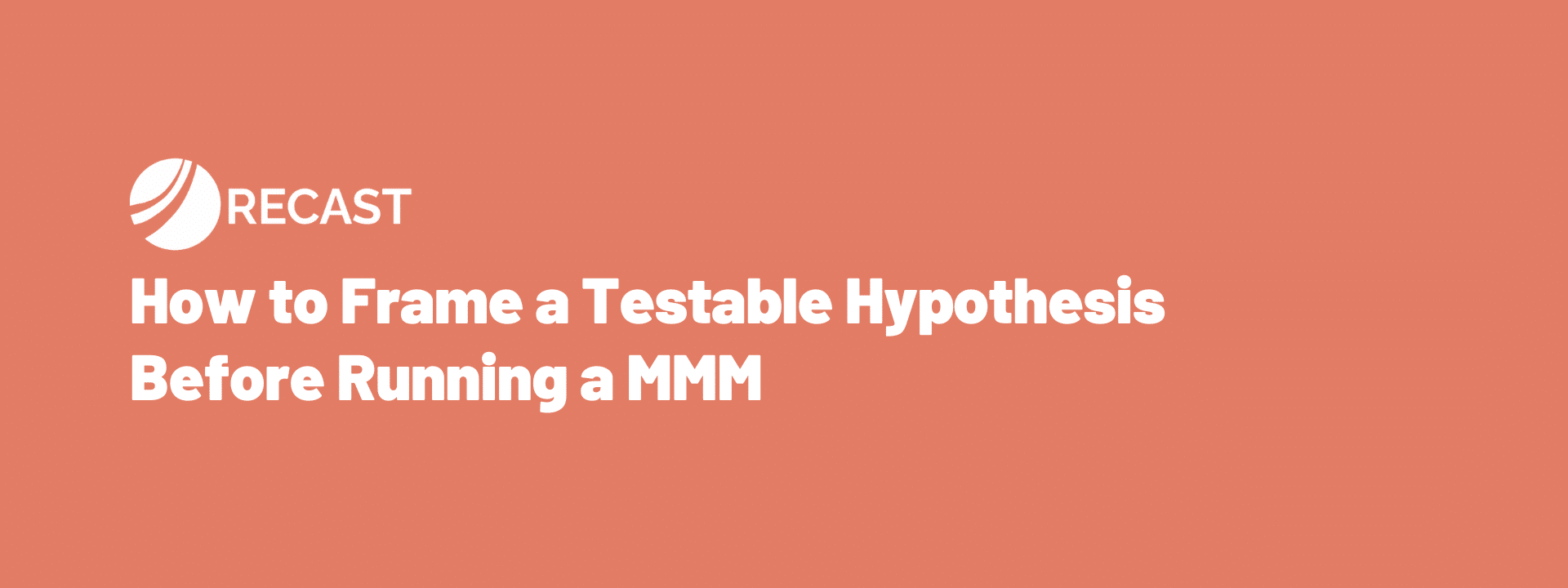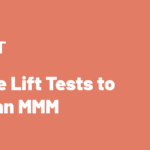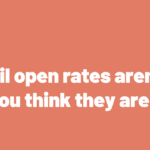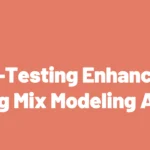The goal of any media mix model (MMM) isn’t just to describe past performance — it’s to inform decisions .That means you need hypotheses that lead to falsifiable predictions that can be proven wrong — or right — based on the data. It gives your model a job, a target to shoot for, and a structure for interpreting the results.
Take this common example:
“Meta is working well.”
This is not a testable hypothesis. It’s too vague. “Well” could mean efficient, scalable, above average, or anything else. You can’t falsify it, and you certainly can’t use a model to confirm or reject it in a useful way.
Now compare that to:
“Meta has an incremental ROI between 2x–4x at current spend levels, and adding $200K in Q2 will return at least a 2.5x ROI.”
It’s quantitative, bounded, and outcome-driven. It can be tested through modeling, experimentation, or both — and it points directly to a budget recommendation.
This framing shift — from “what’s happening” to “what if” — is what transforms MMM from a reporting tool into a causal decision engine.
At Recast, we think of every MMM as part of a broader incrementality system where hypotheses can be generated, tested, validated, and used to guide action.
3 Sources for Generating Testable Hypotheses
So you need hypotheses to feed your incrementality system, but where should you source them from? The sharpest teams we work with use three main sources to generate hypotheses worth testing.
1. Marketing intuition
Great marketers are pattern recognizers. They see what channels are undervalued, which creatives are resonating, and how customer behavior is shifting. Those instincts are a legitimate input to hypothesis development.
If you’ve run enough campaigns, you’ve probably seen something like this:
“We think linear TV is more incremental than the data shows, but attribution is under-crediting it.”
That’s a valid hypothesis. It’s rooted in context that’s not always in the data — like creative resonance, audience overlap, or channel synergy. And it can absolutely be tested, either through the model or through experimentation.
2. MMM uncertainty and outputs
Too often, marketers treat MMM outputs as fixed truths. But the best models include confidence intervals, not just point estimates. Those ranges are signals. They highlight where the model is uncertain and where testing can unlock the most value.
Let’s say your model estimates that Meta Retargeting has an incremental ROI somewhere between 1x and 5x. That’s not a conclusion — go and investigate!
Should you increase spend? Decrease it? Run a test to narrow the range? The uncertainty tells you where your signal is weak and where a hypothesis-driven test could deliver the most value.
This is one of the most powerful ways to use MMM: not as a final answer, but as a triage tool to prioritize your learning roadmap.
Another signal is spikes that don’t behave as expected.
For example, you might notice that promotions are pulling forward demand and depressing post-period sales. That pattern alone is enough to spark a hypothesis:
“Our Black Friday campaign increases total revenue, but net lift is lower than it appears due to demand distortion.”
You can validate that by modeling more spike shapes, running clean calendar holdouts, or triangulating against prior years.
Or maybe the model shows that brand awareness is amplifying paid media performance. That could lead to:
“A 5-point increase in brand awareness increases Meta effectiveness by 20%.”
Again: testable, measurable, and strategy-relevant.
3. Contradictory signals across measurement tools
When your attribution model, MMM, and brand lift study disagree, that doesn’t mean they are broken — they’re pointing to what you don’t yet understand.
Maybe your MMM shows podcasting underperforms, but your post-purchase survey has it leading on “how did you hear about us?” That’s a contradiction, but also a useful one. It can drive a falsifiable hypothesis:
“Podcasting drives top-of-funnel awareness, not direct conversions. Its impact is underrepresented in short-term attribution models.”
Dig deeper, maybe by running a geographic experiment to break the tie.
The key is to treat each contradiction or ambiguity as a question — not a failure. Your model isn’t supposed to answer everything. It’s supposed to tell you where to look next.
How to Validate Hypotheses in MMM
Once you have a hypothesis, go and test it. Here are the most effective tools we and our customers use to validate model-driven hypotheses.
1️⃣ Parameter recovery with synthetic data
This is the gold standard for testing your model’s internal mechanics. You generate synthetic data where you already know the “ground truth” ROI values for each channel. Then you feed that data into the model and see if it recovers the right parameters.
If it can’t recover known effects, it’s not ready for production use — let alone for guiding budget decisions.
2️⃣ Out-of-sample forecast accuracy
True causality means your model should make accurate predictions about the future. The best way to test that is through out-of-sample forecasts.
You hold back a portion of historical data, train the model without it, and ask: can the model accurately predict what happens next?
At Recast, we run rolling backtests like this every week. If a model consistently fails to predict unseen data, we flag it. That feedback loop is essential for maintaining trust in the system.
3️⃣ Geo holdout testing (e.g., Recast Geolift)
When you want to resolve a high-uncertainty estimate or test a bold hypothesis, geographic experimentation is one of the most powerful tools available.
Recast Geolift lets you run holdout tests — either reducing or increasing spend in selected regions — and simulates expected lift before you even launch. It accounts for your business’s actual geography, budget, and KPI structure, helping you design tests with real statistical power.
Once the test is live, Recast uses synthetic controls to analyze outcomes with confidence intervals and ROI estimates that fold directly back into your MMM. It’s a clean, closed-loop system.
4️⃣ Real-world interventions
Sometimes the simplest test is a planned change. You adjust spend in a specific channel, region, or time period and track what happens. If your MMM predicted the outcome accurately, that’s a powerful validation.
And if it didn’t? That’s a signal to revisit your priors, rerun parameter checks, or question the model’s underlying assumptions.
Validation isn’t a one-time step — it’s part of an ongoing incrementality system. Hypotheses lead to tests. Tests lead to learning. And every new insight helps tune the model and make your next hypothesis more precise.
Recap: How to Build a Testable Hypothesis in MMM 🔁
- Vague beliefs like “Meta is working” aren’t testable — they’re assumptions
- A strong MMM hypothesis is quantitative, bounded, and decision-relevant
- Use model uncertainty, intuition, and conflicting signals to generate hypotheses
- Validate hypotheses with tools like:
- Synthetic data
- Out-of-sample forecasts
- Geo holdout tests
- Real-world interventions
- Treat every contradiction as a question and every test as a chance to learn



